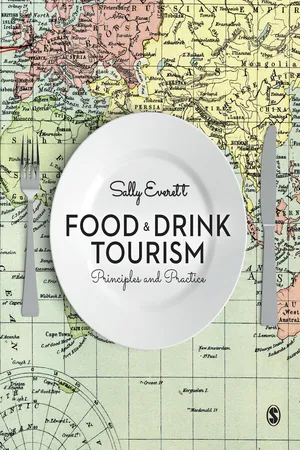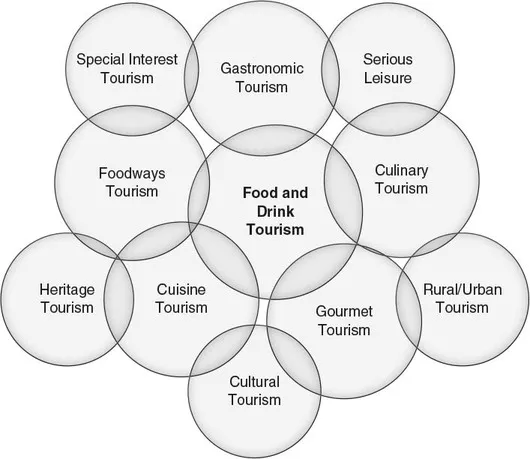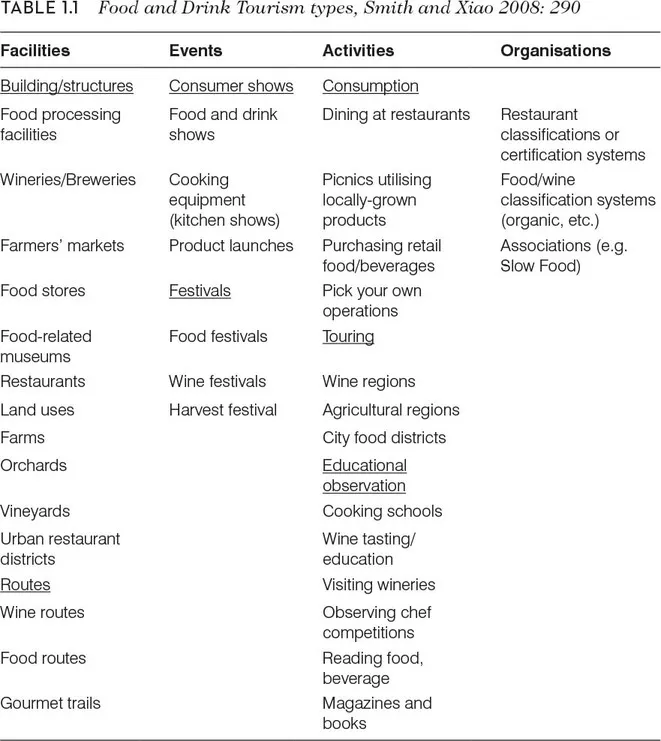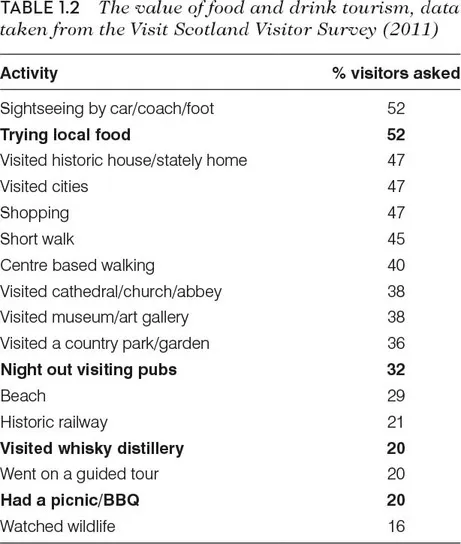
This is a test
- 464 pages
- English
- ePUB (mobile friendly)
- Available on iOS & Android
eBook - ePub
Book details
Book preview
Table of contents
Citations
About This Book
Dedicated to the growing field of food and drink tourism and culinary engagement, Sally Everett offers a multi-disciplinary approach to the subject, embracing theories and examples from numerous subject disciplines. Through a combination of critical theory reflections, real-life case studies, media excerpts and activities, examples of food and drink tourism around the world as well as a focus on employability, Food and Drink Tourism provides a comprehensive & engaging resource onthe growingtrend offood motivated travel & leisure. Suitable forany student studying tourism, hospitality, events, sociology, marketing, business or cultural studies.
Frequently asked questions
At the moment all of our mobile-responsive ePub books are available to download via the app. Most of our PDFs are also available to download and we're working on making the final remaining ones downloadable now. Learn more here.
Both plans give you full access to the library and all of Perlego’s features. The only differences are the price and subscription period: With the annual plan you’ll save around 30% compared to 12 months on the monthly plan.
We are an online textbook subscription service, where you can get access to an entire online library for less than the price of a single book per month. With over 1 million books across 1000+ topics, we’ve got you covered! Learn more here.
Look out for the read-aloud symbol on your next book to see if you can listen to it. The read-aloud tool reads text aloud for you, highlighting the text as it is being read. You can pause it, speed it up and slow it down. Learn more here.
Yes, you can access Food and Drink Tourism by Sally Everett in PDF and/or ePUB format, as well as other popular books in Business & Hospitality, Travel & Tourism Industry. We have over one million books available in our catalogue for you to explore.
Information
Part One The Growth and Development of Food and Drink Tourism
1 What is Food and Drink Tourism?
Chapter Objectives
- To provide some definitions of food and drink tourism and related terms
- To introduce different typologies and models of food and drink tourists
- To illustrate the breadth and variety of the food and drink tourism on offer
- To assess the value and contribution of food and drink tourism to local communities, economies, and the environment
- To provide an introductory reading list covering topics throughout this book
Chapter Summary
This first chapter introduces the concept of food and drink tourism. It provides definitions and models, and discusses the different typologies of the (food) tourist that have been used and adopted. It draws recent work together to provide an overview of the sector and its various components. In offering an outline of the different types of food and drink tourism (food tourism, gastronomic tourism, culinary tourism, special interest tourism, cultural tourism) and linking them with key aspects (such as events, festivals, trails, cookery, shops, museums, vineyards, breweries, restaurants), this chapter gives you a real ‘taste’ of what is covered in the rest of the book. The chapter briefly discusses the various components of food-motivated travel and outlines the size and scale of the industry. Importantly, countries around the world are using food as a means to extend their tourist season, alleviate poverty, diversify their offer, and regenerate areas of deprivation (e.g. Rwanda, Malaysia, Mauritius and Croatia) and examples are provided to highlight the role and extensive reach of food tourism. It also provides a brief commentary on the emerging food and sustainability agenda, and outlines issues affecting global food and drink production and consumption today.
What is Food and Drink Tourism?
There are numerous definitions of food and drink tourism and it is unlikely that we will ever agree upon one. It is probably best that one single definition is not established because it would undermine and overly simplify the very nature of this ever-changing, multi-faceted and complex activity. Similarly, as scholars have struggled to define ‘tourism’ due its multi-dimensional and contested nature, it would be misleading and unhelpful to frame ‘food and drink tourism’ within rigid conceptual boundaries. One of the main issues is what to even call the activity, because there are many terms and categories that cover slightly different aspects of food and drink tourism (and significantly overlap), which are summarised below (with wider forms of tourism acting as unifying terms) (Figure 1.1).
Figure 1.1 Different types and categories of food and drink tourism

Perhaps one of the broadest definitions given for food tourism is provided by the World Food Travel Association (WFTA, 2015) (previously known as the International Culinary Tourism Association), as ‘something every visitor does’ (see http://worldfoodtravel.org). This is certainly testament to its centrality in the tourism experience, although perhaps its vagueness makes this term rather meaningless. Academic scholars have also offered definitions of ‘food tourism’, which vary over whether food should be the primary motivation, or merely part of the overall touristic experience. The most cited definition to date is Hall and Mitchell (2001: 308), which is the ‘visitation to primary and secondary food producers, food festivals, restaurants and specific locations for which food tasting and/or experiencing the attributes of specialist food production regions are the primary motivating factor for travel’. It is the desire to experience a particular type of food or the produce of a specific region. Certainly Hall and his fellow authors (Hall et al., 2003) regarded it as a form of ‘serious leisure’ (Stebbins, 2007). Another useful definition of food/culinary tourism was provided by Long (2004: 7):
Culinary tourism is any tourism experience in which one learns about, appreciates, or consumes branded local culinary resources. In other words, culinary tourism is an intentional and reflective encounter with any culture, including one’s own through culinary resources. Culinary tourism encompasses travel specifically motivated by culinary interests as well as travel in which culinary experiences occur but are not the primary motivation for the trip.
Perhaps it could simply be defined as ‘food and drink motivated travel’, which reflects any level of desire to engage in an experience involving food and drink away from home (primary or secondary motivation). Other types and sectors of tourism also include elements of food and drink tourism, such as cultural tourism (attractions and local cuisines), festival and event tourism (food and drink festivals and events), and heritage tourism (museums and places of production). It is its embedded nature that makes it difficult to define and pin down, but simultaneously ensures it should be at the forefront of any curriculum looking at tourism.
However, this book primarily focuses on activities undertaken by those who make a conscious effort to visit specific food/drink tourism sites (pre-meditated (primary) or decision once in the location (secondary)) and those who consciously produce and deliver these experiences, rather than an exploration of the more generic hospitality sector in tourism (although this is briefly discussed in the context of the supply chain in Chapter 20). Food and drink tourism is certainly an eclectic term, if not a phenomenon, and covers myriad different aspects of the touristic experience. An indicative typology of culinary tourism is provided below, adapted from Smith and Xiao (2008: 290). It highlights the multiplicity of experiences that can be associated with this area of tourism, illustrating the diverse characteristics and elements of this sphere of tourism activity.

Who is the Food Tourist?
Lacy and Douglass (2002: 8) claim that ‘every tourist is a voyeuring gourmand’ and indeed all tourists eat and drink; however, this may be a little simplistic when we wish to look more closely at the market. Rather, the food and drink ‘tourist’ should be conceptualised on a spectrum from someone with very high interest where the primary motivation is to engage in food and drink related activities in line with the ‘food tourist’ or ‘gastronome’ to low and no interest (no interest in food and drink and likely to avoid local food establishments, equating to the ‘laggard’). The seminal tourist typology by Cohen (1979) was taken by Everett and Aitchison (2008) to examine the correlation between interest and food tourism type. A revised version is provided here to give an overview of the relationship between tourist ‘type’ and the level of spend, activity and market size (Figure 1.2). These aspects will be discussed further in Part 2.
Figure 1.2 The correlation between tourist type and food tourism engagement. (Source: Everett and Aitchison 2008, permission granted by publisher)

There is clearly a growing general interest in trying local foods, visiting local markets and engaging with gastronomic establishments when on holiday. The Visit Scotland Visitor Survey (Visit Scotland, 2011) highlights the significant level of interest in trying local food, with its survey reporting that 52% of visitors wanted to try local foods (Table 1.2 presents data from this survey with food-related activity in bold).

It has been found that food and beverage constitute up to one-third of total tourist expenditure (Kim et al., 2009a; Meler and Cerović, 2003) and has become a distinct sector in the travel and tourism industry, rather than an inconsequential holiday necessity. The World Food Travel Association estimated that food tourism is worth nearly $8 billion each year in the United Kingdom (ICTA, 2012), which is testament to its contribution to the rapid growth of new forms of special interest and niche tourism. Although the spend per head on food and drink varies across locations and according to tourist markets, recent reports suggest tourists to the UK and USA spend 36% of their total expenditure on food and drink (ICTA, 2012), 21% or £700m/year in Scotland (Visit Scotland, 2011), and 33% in Northern Ireland (Northern Ireland Tourist Board, 2012). In Jamaica, the daily expenditure on food by the tourist is five times greater than that of the average Jamaican, which highlights its important economic contribution. Research has found that among all possible areas of expenditures while travelling, tourists are least likely to make cuts in their food budget. Consequently, there are significant opportunities to work and get involved in this growing industry sector.
Travelling to destinations in order to sample, taste and experience the food or drink of a particular region or culture is certainly not a new phenomenon; the human desire to experience place through the palette has a long and traceable history (as discussed in Chapter 2). However, there has been a significant rise in forms of tourism consumption that intimately engage with the gastronomic landscape (Hjalajer and Richards, 2002). As part of a rise in new consumption patterns and niche tourism activities (discussed in Chapter 4), food- and drink-motivated travel is gathering momentum. Within the past 20 years, food and drink have become significant ‘pull’ factors in their own right (Okumus et al., 2007), and provide a touristic framework on which to construct a destination’s overall marketing strategy (discussed further in Part II on branding and marketing).
The World Travel Market spokesperson, Fiona Jeffery, exclaimed that ‘food tourism is on the boil like never before, holiday makers are choosing where they go by what they can put into their stomachs… food tourism today is where ecotourism was 20 years ago’ (World Travel Market 2008). This textbook has emerged from this gastronomic climate and seeks to engage with food tourism as a way of helping you explore and understand ‘undigested’ areas of tourism, culture, economic development and hospitality. By embracing different disciplinary theoretical and empirical ‘ingredients’, the book aims to provide you with a comprehensive and useful text that you can use to support your studies.
Working with food and drink tourism: a growing industry
Tourism is a fast growing global industry and in many parts of the world, employment in this sector is the largest sector in the country. Figures are mainly taken from the World Travel and Tourism Council (WTTC) which produces tourism reports of the economic and employment impact of 184 countries and 25 geographic or economic regions in the world.
Global Picture
International tourist arrivals grew by 4.3 % in 2014 to 1.133 billion in 2015. In 2014, international tourism generated US$ 1.5 trillion in export earnings and contributed 10% of global GDP, and accounted for 1 in 11 jobs (UN World Tourism Organisation (WTO) 2015). The World Travel & Tourism Council (WTTC) anticipates that tourism will have a global value of US$ 10.8 trillion by 2018, almost double its present worth in 2015. The UN’s World Tourism Organisation claims that by 2020, the number of travelling tourists will approach 1.6 billion. By 2022, it is anticipated that tourism will support 328 million jobs, or one in every ten jobs, and half will be in the food, hospitality and hotel sector. For example, by 2018, tourism is projected by the WTTC to be worth 80% of the GDP of Antigua and Barbuda, with 95% of all jobs there expected to be related in some way to tourism, which is the highest dependency on the planet (WTTC, 2015).
European Union
In the EU, the direct contribution of tourism to GDP was US$ 669.9bn (3.6% of total GDP) in 2014, and is forecast to rise by 3.0% in 2015, and to rise by 2.7% p.a. from 2015–2025, to US$ 898.7bn (4.0% of total GDP) in 2025 (WTTC, 2015). In 2014 tourism directly supported 11,062,000 jobs (5.0% of total employment). This is expected to rise by 2.3% in 2015 and by 1.5% p.a. to 13,123,000 jobs (5.7% of total employment) in 2025. In 2014, indirect jobs in the EU supported by the industry were 11.1% of total employment (24,694,000 jobs). This is expected to rise by 2.1% in 2015 to 25,206,500 jobs and by 1.2% p.a. to 28,367,000 jobs in 2025 (12.3% of total). By 2025, tourism and the Horeca (this term refers to hotel, restaurant and catering companies covering Hotel/Restaurant/Café) sector will account for 13,123,000 jobs directly, an increase of 1.5% p.a. over the next ten years.
United Kingdom
Based on the WTTC Travel & Tourism Economic Impact study (WTTC, 2015) the direct contri...
Table of contents
- Cover
- Half Title
- Publisher Note
- Title Page
- Copyright Page
- Acknowledgements
- Contents
- About the Author
- Acknowledgements
- Introduction (An Appetiser)
- Part One The Growth and Development of Food and Drink Tourism
- 1 What is Food and Drink Tourism?
- 2 A History of Culinary Exploration and Food Tourism
- 3 Identity Development and the Cultural Dimension of Food and Drink
- 4 Niche Tourism and the Growth of Food-Inspired Travel
- 5 The Globalisation and Localisation of Food and Drink
- 6 Food, Tourism and Agricultural Policy
- 7 Wine Tourism and the Development of ‘Winescapes’
- Part Two The Promotion and Branding of Food and Drink Tourism
- 8 Marketing and Branding Food and Drink Tourism
- 9 The Role of Media and Social Media in Promoting Food and Drink Tourism
- 10 Managing Food Tourism: On-Site Marketing and Interpretation
- 11 Food Assurance Schemes, Organisations and Initiatives
- Part Three Food and Drink Attractions and Events
- 12 The Transformation of Place Through Food and Drink
- 13 Food and Drink Festivals, Events and Markets
- 14 Food- and Drink-Inspired Events: The Weird and Wonderful
- 15 Following Food and Drink: Tours, Trails and Routes
- 16 Food and Drink Visitor Attractions
- 17 Beverage Tourism: Drinking to Experience People and Place
- 18 The Role of Food and Drink Tourism in Sustainable Development
- 19 When Consumers Become Producers
- 20 The Food and Drink Tourism Supply Chain
- 21 Local Food and Drink in the Hospitality Sector
- 22 The Future of Food and Drink Tourism
- References
- Index